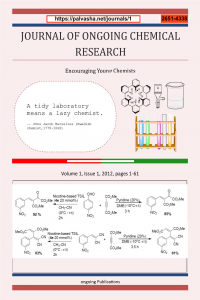Synthesis and Structural Characterization of Mono Acid-type partial Cone Conformation Azocalix[4]arene
Synthesis and Structural Characterization of Mono Acid-type partial Cone Conformation Azocalix[4]arene
Structural Properties, Azocalix[4]arene, Calix[n]arene, Diazo-coupling Reaction Partial Cone Conformation,
___
- [1] H. Deligz, S. Memon, Overview on Metal Cations Extraction by Azocalixarenes, Pakistan Journal of Analytical & Environmental Chemistry 12(1 & 2) (2011) 24.
- [2] S. Shimizu, S. Shirakawa, T. Suzuki, Y. Sasaki, Water-soluble calixarenes as new inverse phase-transfer catalysts. Their application to aldol-type condensation and Michael addition reactions in water, Tetrahedron 57(29) (2001) 6169-6173.
- [3] S. Elçin, M.M. Ilhan, H. Deligöz, Synthesis and spectral characterization of azo dyes derived from calix [4] arene and their application in dyeing of fibers, Journal of Inclusion Phenomena and Macrocyclic Chemistry 77(1) (2013) 259-267.
- [4] J. Rebek Jr, Host–guest chemistry of calixarene capsules, Chemical Communications (8) (2000) 637-643.
- [5] K. Sharma, P. Cragg, Calixarene based chemical sensors, Chemical sensors 1(9) (2011) 1-18.
- [6] I. Leray, B. Valeur, Calixarene‐based fluorescent molecular sensors for toxic metals, European Journal of Inorganic Chemistry 2009(24) (2009) 3525-3535.
- [7] X. Fan, X. Guo, Development of calixarene-based drug nanocarriers, Journal of Molecular Liquids 325 (2021) 115246.
- [8] W. Śliwa, Calixarene complexes with transition metal ions, Journal of inclusion phenomena and macrocyclic chemistry 52(1) (2005) 13-37.
- [9] F. Yang, H. Guo, J. Vicens, Mini-review: calixarene liquid crystals, Journal of Inclusion Phenomena and Macrocyclic Chemistry 80(3) (2014) 177-186.
- [10] Z. Niu, Y. Liu, X. Li, H. Zhu, M. Zhang, K. Yan, H. Chen, Colorimetric detection of sulfamethazine based on target resolved calixarene derivative stabilized gold nanoparticles aggregation, Microchimica Acta 189(2) (2022) 1-7.
- [11] S. Thakkar, L.F. Dumée, M. Gupta, B.R. Singh, W. Yang, Nano–enabled sensors for detection of arsenic in water, Water Research 188 (2021) 116538.
- [12] K. Singh, S. Sharma, S. Shriwastava, P. Singla, M. Gupta, C. Tripathi, Significance of nano-materials, designs consideration and fabrication techniques on performances of strain sensors-A review, Materials Science in Semiconductor Processing 123 (2021) 105581.
- [13] A. Anandababu, S. Anandan, A. Syed, N. Marraiki, M. Ashokkumar, Upper rim modified calix [4] arene towards selective turn-on fluorescence sensor for spectroscopically silent metal ions, Inorganica Chimica Acta 516 (2021) 120133.
- [14] B. Gassoumi, M. Echabaane, F.B. Mohamed, L. Nouar, F. Madi, A. Karayel, H. Ghalla, M. Castro, F. Melendez, S. Özkınalı, Azo-methoxy-calix [4] arene complexes with metal cations for chemical sensor applications: Characterization, QTAIM analyses and dispersion-corrected DFT-computations, Spectrochimica Acta Part A: Molecular and Biomolecular Spectroscopy 264 (2022) 120242.
- [15] H.M. Chawla, P. Goel, R. Shukla, D.S. Black, N. Kumar, New lower rim looped calix [4] arene for ratiometric and chromogenic recognition of Cu2+, Journal of Inclusion Phenomena and Macrocyclic Chemistry 80(3) (2014) 201-207.
- [16] H. Deligöz, Azocalixarenes: synthesis, characterization, complexation, extraction, absorption properties and thermal behaviours, Journal of inclusion phenomena and macrocyclic chemistry 55(3) (2006) 197-218.
- [17] M. Yilmaz, H. Deligöz, Studies on Compounds of Uranium (M) with Two vic Dioxime Derivatives of Gilixi [4] Arene, Synthesis and reactivity in inorganic and metal-organic chemistry 28(5) (1998) 851-861.
- [18] A.B. Descalzo, K. Rurack, H. Weisshoff, R. Martínez-Máñez, M.D. Marcos, P. Amorós, K. Hoffmann, J. Soto, Rational design of a chromo-and fluorogenic hybrid chemosensor material for the detection of long-chain carboxylates, Journal of the American Chemical Society 127(1) (2005) 184-200.
- [19] E.J. Cho, B.J. Ryu, Y.J. Lee, K.C. Nam, Visible colorimetric fluoride ion sensors, Organic letters 7(13) (2005) 2607-2609.
- [20] Y. Lu, W. Liao, Extraction and separation of trivalent rare earth metal ions from nitrate medium by p-phosphonic acid calix [4] arene, Hydrometallurgy 165 (2016) 300-305.
- [21] A. Bayrakdar, H.H. Kart, S. Elcin, H. Deligoz, M. Karabacak, Synthesis and DFT calculation of a novel 5, 17-di (2-antracenylazo)-25, 27-di (ethoxycarbonylmethoxy)-26, 28-dihydroxycalix [4] arene, Spectrochimica Acta Part A: Molecular and Biomolecular Spectroscopy 136 (2015) 607-617.
- [22] H. Deligöz, Synthesis of oligomer and styrene polymer-supported calix [4] arene derivatives and selective extraction of Fe3+, Supramolecular Chemistry 15(5) (2003) 317-321.
- [23] O.A. Yesypenko, A.O. Osipova, O.O. Tribrat, S.O. Kravchenko, O.M. Usachov, V.V. Dyakonenko, A.B. Ryabitskii, V.V. Pirozhenko, S.V. Shishkina, A.B. Rozhenko, Synthesis and enantiorecognition properties of stereoisomeres of inherently chiral propyloxy-octyloxy-calix [4] arene acetic acids, Tetrahedron 80 (2021) 131894.
- [24] C.H.C. Zacchi, S.S. Vieira, J.D. Ardisson, M.H. Araujo, A. de Fatima, Synthesis of environmentally friendly, magnetic acid-type calix [4] arene catalyst for obtaining Biginelli adducts, Journal of Saudi Chemical Society 23(8) (2019) 1060-1069.
- [25] S. Sayin, M. Yilmaz, Brønsted acidic magnetic nano-Fe3O4-adorned calix [n] arene sulfonic acids: synthesis and application in the nucleophilic substitution of alcohols, Tetrahedron 70(37) (2014) 6669-6676.
- [26] S. Elçin, H. Deligöz, A versatile approach toward chemosensor for Hg2+ based on para-substituted phenylazocalix [4] arene containing mono ethyl ester unit, Dyes and Pigments 107 (2014) 166-173.
- [27] Y. Morita, T. Agawa, E. Nomura, H. Taniguchi, Syntheses and NMR behavior of calix [4] quinone and calix [4] hydroquinone, The Journal of Organic Chemistry 57(13) (1992) 3658-3662.
- [28] C.D. Gutsche, Calixarenes, Accounts of Chemical Research 16(5) (1983) 161-170.
- [29] K. Park, H.-J. Son, J.-I. Choe, mPW1PW91 study for conformational isomers of methylene bridge-monosubstituted tetramethoxycalix [4] arenes, Journal of Industrial and Engineering Chemistry 20(5) (2014) 3276-3282.
- [30] A. Arduini, A. Pochini, S. Raverberi, R. Ungaro, p-t-Butyl-calix [4] arene tetracarboxylic acid. A water soluble calixarene in a cone structure, Journal of the Chemical Society, Chemical Communications (15) (1984) 981-982.
- ISSN: 2651-4338
- Başlangıç: 2012
- Yayıncı: SciMatic Yazılımları Danışmanlık
GEOLOGICAL, MINERALOGICAL, GEOCHEMICAL PROPERTIES, AND CHARACTERIZATION OF MARINE ZEOLITE
Can sunflower honey have a protective effect against Alzheimer's disease?
An Innovative Synthesis of Nano-ZSM-5 Zeolite Through Interrupted Ultrasound
Pirzada AFRİDİ, Farrukh Arsalan SİDDİQUİ, Sergio GONZALEZ-CORTES, Liam FRANCE
